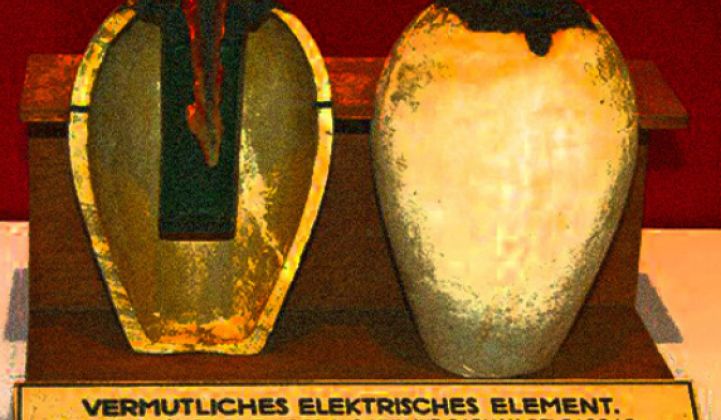GTM attended last week's Bay Area Battery Summit at the Stanford Linear Accelerator Center and witnessed a presenter (who shall remain anonymous) claim without reservation that the first battery, the first electrochemical cell, was about 2,500 years old. It was supposedly discovered at a Mesopotamian archeological dig near Baghdad, Iraq (or possibly in the basement of the Baghdad Museum).
He said, "This is the very first one, the Baghdad Battery."
"This was the first battery that we know of, and it was basically a clay jar with a copper cylinder, probably surrounded by lemon juice or something like that."
Supposedly discovered in 1936, the 6-inch-tall clay pot was sealed with bitumen and contained a copper cylinder surrounding an iron rod. A number of similar specimens have been found. Experiments have been conducted which demonstrate that the vessel, when filled with a liquid electrolyte, could act as an electrochemical cell. It has been speculated that the cells might have been used to electroplate metal or as an igniter.
No archeologist accepts that the jar is a battery. It is more likely a sealed jar containing the metal remnants of a scroll.
The Babylon Battery falls more under the category of Nazca Lines being interpreted as alien runways and Ben Carson's theory that Egyptian pyramids were used as grain silos.
What is it about batteries? "Just as soon as a man gets working on the secondary battery, it brings out his latent capacity for lying," in the words of Thomas Edison.
The actual origin of batteries is not as old as Iraq, but still tells a beautiful scientific history in the transition from the Enlightenment to the Industrial Age.
- 1744, the Leyden jar: The concept for the Leyden jar was arrived at independently by Dutchmen Musschenbroek and Cunaeus and German scientist Ewald Georg von Kleist. It was essentially a capacitor that stored a charge between two metal plates. A number of jars could be connected in parallel to form a “battery” (the term was coined by Benjamin Franklin) to raise the potential stored charge.
- 1800, the first electrochemical cell: Alessandro Volta invented the copper-zinc "voltaic pile," for which Napoleon made him a count. This is the first battery. However, Volta incorrectly believed that the electromotive force originated at the contact between two metals and not through a chemical reaction.
Volta's Voltaic Pile

Photo by I, Guido B (Creative Commons)
- 1859, rechargeable batteries: French scientist Gaston Planté's lead-acid batteries were the first iteration of the rechargeable, or secondary, battery.
OK. Now that we've straightened out the history of batteries, we'd also like to give you something in renewable energy to be thankful for, in what will surely be tumultuous years ahead. And right now, that would seem to be energy storage.
Matt Roberts of the Energy Storage Association spoke of the recent FERC ruling and said, "All of that bodes very well for what we generally call grid-scale energy storage, transmission-scale energy storage. The really innovative piece in this that was further than we anticipated them taking this was around distributed energy resources. Now they're saying that they also want to make sure that distributed resources can aggregate together and operate in the wholesale market."
Alex Morris of the California Energy Storage Association said, "The good news -- and just to juxtapose the California situation with the national situation -- is the clean energy future in California seems pretty clear and bright, and, if anything the recent election involved a lot of local leaders being elected who ran on clean energy platforms."
Walker Wright of Green Charge Networks said, "I technically work for Engie, which is formerly GDF Suez, which is the largest independent power producer in the world. In April, Engie acquired Green Charge, and the mantra in Paris, where Engie's headquarters is, is simply, 'The future of power must be decarbonization, decentralization and digitalization.'
"As they look out across their global markets, they're operating in about 170 countries, they're looking at Western Europe, the U.S., South Korea, and Japan, where right now, Engie's in the process of literally selling off billions of dollars' worth of traditional fuel assets. It's one of the biggest stories in the world of energy right now, and within the next two weeks, they're going to sell off about 4.5 billion dollars' worth of natural gas facilities here in the United States."
Julie Blunden, formerly of SunEdison and SunPower, spoke at this same storage event, and was extremely bullish on energy storage. She said, "Let me just emphasize the policy appetite for energy storage is fundamentally different than any new policy for clean, advanced, different, competitive resources I've worked on in my 30-year career. I cannot emphasize how important that is, because it changes the pace of penetration. In fundamental contrast to every other source, be it energy efficiency, demand response, solar, wind, whatever, the utilities want energy storage so badly, they'll take whatever you can give them."
"You've got batteries that are meant for electric vehicles? If you can give them at a price point and give them a rate of recovery proposal by their utility commission, they will take it today." She arguably claimed, "They want energy storage so badly, whatever you've got today you can sell. You just have to price it right."
And of course, there's GTM Research's optimistic take on the market.
FIGURE: Annual U.S. Energy Storage Deployments (MW), 2012-2021E
Source: GTM Research's U.S. Energy Storage Monitor
If you work in renewables, it's a time of uncertainty. But energy storage would seem to have a real upside, regardless of the political winds.
Enjoy your holidays.
And make sure to come to GTM's Storage Summit on December 7 and 8. There, you'll be able to network with the biggest names in the storage business -- plus our analyst and editorial teams.



